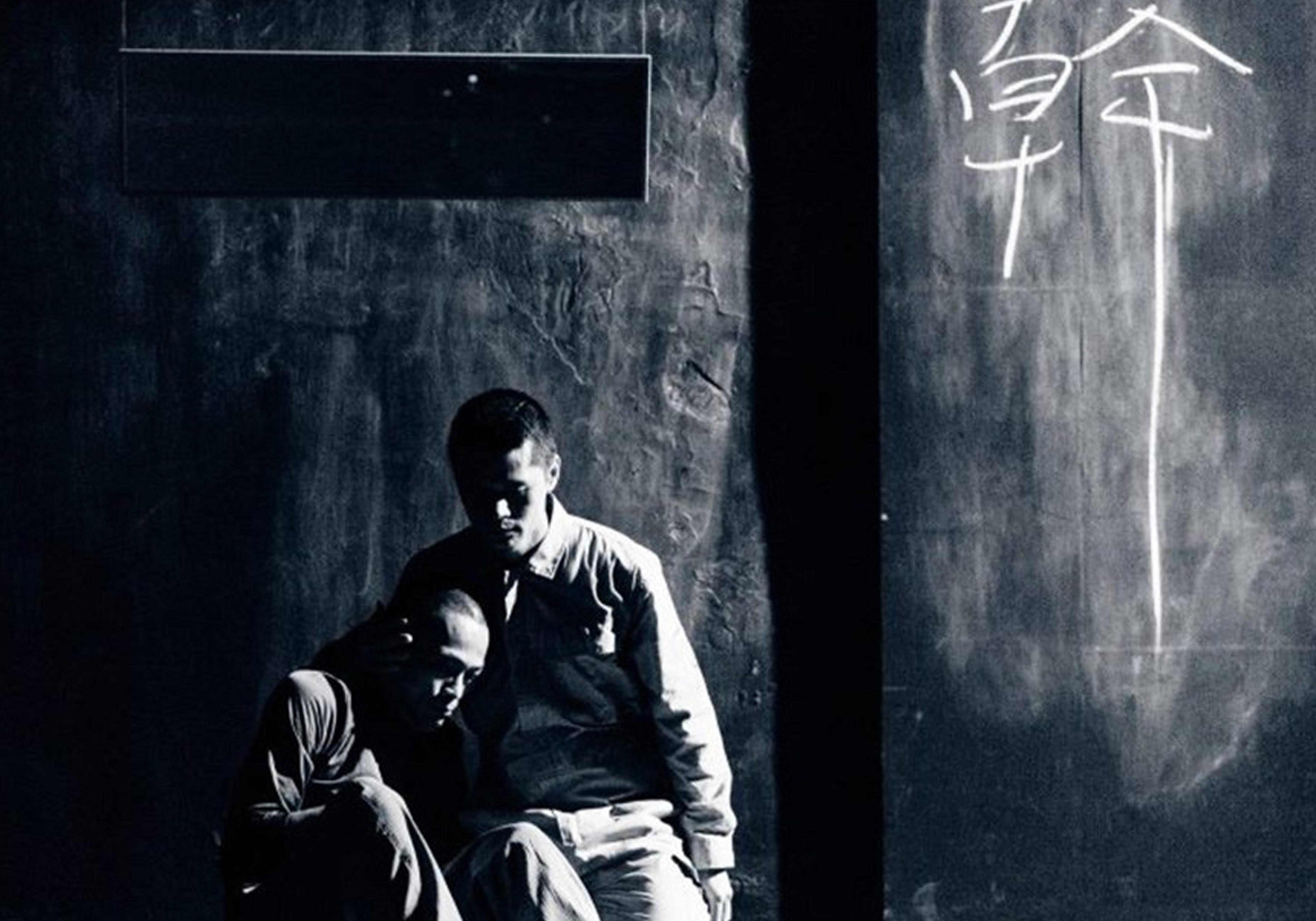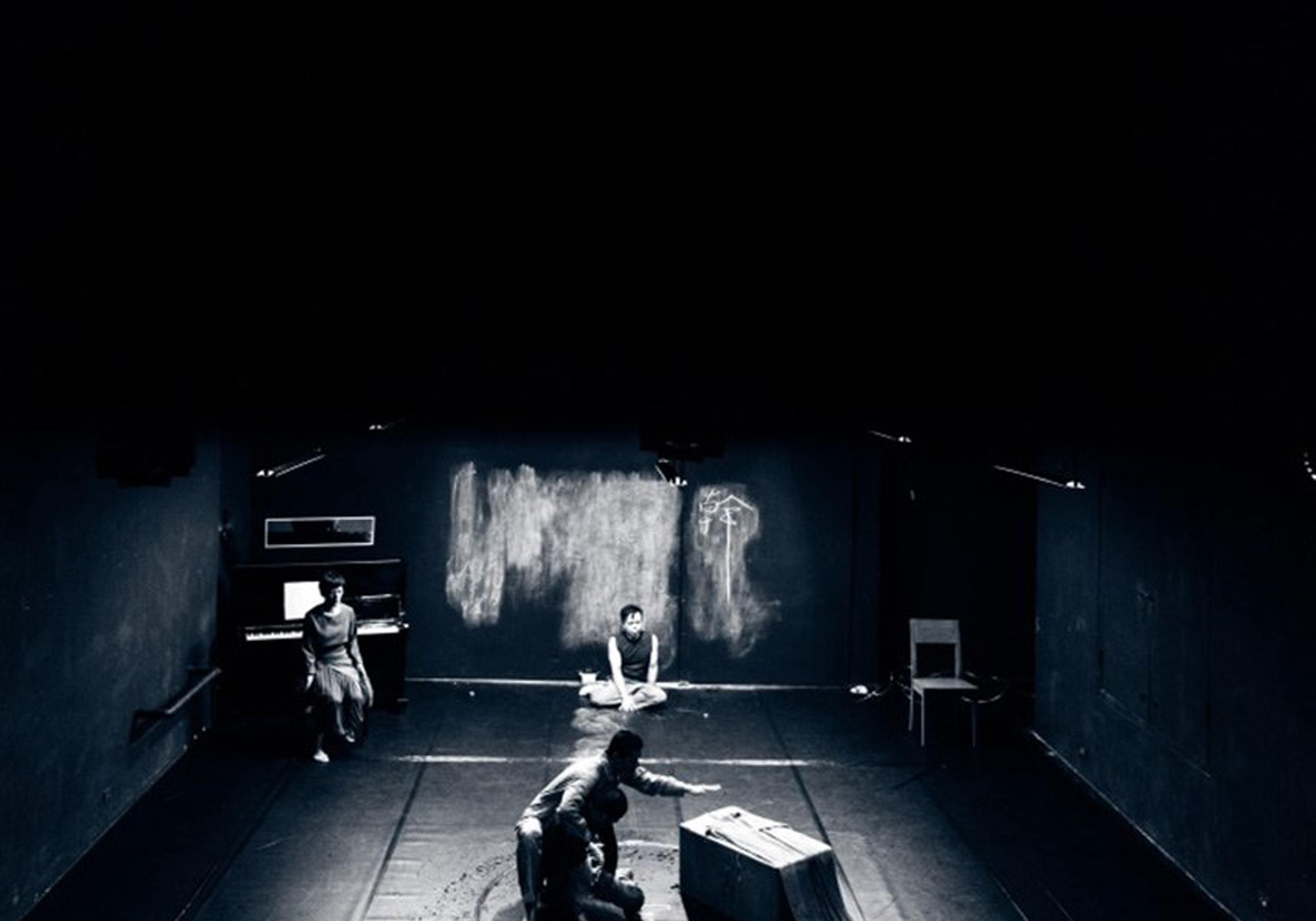關於生之重力的間奏式》三位主要演員形象所蘊含的社會意涵,牢牢附著在他們真實的身體上:姜聲國來自韓國,因腦性麻痺而肢體無法自主靜制;鄭志忠自小罹患小兒麻痺而雙腳萎縮;而李新寶於成年後步上全盲的生涯,且近幾年因交通事故導致右腳踝粉碎性骨折暨左小腿骨裂。整體來理解他們的日常,似乎這活生生的人間世大多數人的慾望也罕能參與進來。由於身心的狀態,真實的生活中,他們擁有相對較短的夜。一來,劇場可以成為一種想像的公共空間,讓他們接觸,讓孤獨與孤獨的接觸,看看從兩兩「(難以)協調」展開,不斷變換、轉化,能夠構成如何的「風景」。同時,不迴避劇場成了一處窺視的場域,讓演員們與觀眾之間去辯證孤獨的樣貌與概念─孤獨者的沉溺與抵抗。
The social meaning conveyed through the three actors in Intermezzo is inherently manifested through their physical bodies. KANG Sung-Kuk from South Korea cannot remain still and silent due to cerebral palsy. CHENG Chi-Chung's leg atrophied due to polio disease. LI Hsin-Pao went entirely blind in adulthood, and due to a recent traffic accident, has suffered from comminuted fracture in his right ankle and fracture in his left calf bone. Most people in this world might not be able to relate to the actors’ everyday life fully. Because of their physical conditions and psychological states, their nights seem to be shorter in real life. For this reason, theatre becomes an imaginable open realm where they may reach out to one another from their solitude. It may seem incredibly challenging to reconcile their physical differences, but as the elements change and evolve, the "scenes" become different. Meanwhile, theatre serves as a voyeuristic site, in which the actors and audience explore the faces and concept of loneliness, or to put it in other words, the indulgence and resistance of those who are alone.
身體氣象館 Body Phase Studio
台灣非營利跨文化交流之先驅藝術團體。於1991年由台灣小劇場先驅人物王墨林所組成,1991年創立迄今,以國際藝術節策畫與劇場製作,成就台灣與世界各地的藝術家彼此交流,進行多面向的美學思辨,為台灣劇場於小劇場運動之後開啟與世界對話之窗。 2001年,創立「第六種官能表演藝術祭」,並長期發展視障者表演藝術,讓「表演人權」思潮真正導入台灣表演美學論述,於東京、北京、香港、首爾等地藝術節與公演,不斷寫下新頁。2005年起,成立「小劇場共同營運實行委員會」,傾力經營牯嶺街小劇場,致力推廣前衛的表演藝術、實驗的跨界藝術及創意的形式藝術,同時,促進時代精神的匯聚、互動、發聲,以期展現真正的文化公共性,將之打造成一亞洲知名的表演創意基地,提攜新世代表演藝術工作者發展嶄新的劇場創意。
The Body Phase Studio is a revolutionary non-profit Taiwanese arts group dedicated to international cultural exchange. It was founded by WANG Mo-Lin, a pioneer of independent theatre in Taiwan in 1991. Since its establishment, through hosting various international arts festivals and theatrical productions, it has enabled Taiwanese artists to exchange aesthetic ideas and perspectives with their international counterparts, opening up a window to the world for local theatre professionals following the Independent Theatre Movement in Taiwan.
In 2001, The Sixth Sense in Performance Arts Festival was founded in the attempt to develop performance art by visually challenged people and introduce “the right to perform” into the discourse of performance art in Taiwan. The festival went on an international public tour in Tokyo, Beijing, Hong Kong, Seoul, etc., and created new records as it progressed. In 2005, The Guling Street Avant-Garde Theatre Executive Committee was founded by the Body Phase Studio to operate the Guling Street Avant-Garde Theatre and promote avant-garde performances, experimental interdisciplinary arts and creative forms. It also advocates the convergence, interaction and opinionating of different groups that uphold the same contemporary spirit, so that culture can truly be shared by the public and that Taiwan can grow into a stronghold of creative performance art in Asia. In this way, younger-generation performance artists shall then be able to further express their innovation and creativity.
關於「第六種官能表演藝術祭」The Sixth Sense in performance Arts Festival
王墨林創立於2001年的「第六種官能表演藝術祭」,從「表演者與工作者在此場合呈現出正常的五種官能之外的另類動作語彙」的發想,產生出「第六種官能表演」,逐步發展為一個獨特的台灣國際藝術節樣貌。歷年,以表演-論壇-工作坊的總合呈現,一屆又一屆從多個面向,無論是身心障礙別,或身分與社會階級的認同與排除──其機制與脈絡,均透過表演者與研究者等把其中豐富的形象在劇場裡引介出來,不僅在以弱勢/身心障礙者通過表演,改變一般人對障礙身體不能自主活動的刻板印象,同時也從中發展、累積新的在地身體表演形式的美學思考。
In 2001, WANG Mo-Lin founded The Sixth Sense in Performance Arts Festival. The idea originated from eliciting "the performers and practitioners' alternative language of movements other than the five senses" to create "the performance arts of the sixth sense." The idea gradually developed into a distinctive international performance arts festival in Taiwan. Throughout the years, the festival has presented a comprehensive integration of performances, forums, and workshops. Each time, the festival tackles multiple aspects of its targeted issues, be it the differences of the physically and mentally challenged people or the identification and exclusion resulting from identity and social class, along with their mechanism and context. These rich images are introduced by the performers and researchers through theatre. Not only the disadvantaged or physically and mentally challenged people are able to alter the stereotypical impression that their challenged bodies prevent them from any autonomous activities, a type of new and local aesthetic thinking of physical performance can be developed and accumulated from the experiences.
姜聲國(韓國)、鄭志忠、李新寶、黃志勇
黃柔閩
姚立群
李婉菁
陳冠霖
周君樸
彭珮瑄
王君盈
林育全
楊政
李允中、王廣耘、蔡承翰
王永宏
廖子萱
馮筱芹、林芊蓉、林繹家
潘振宇
陳藝堂
穀雨展演協創
林育全
陳昱君、楊凱婷、韓謹竹、官家如、黃佩蔚、劉宇真、楊凱絜、黃洛瑤
牯嶺街小劇場
關鍵字
評審談作品
面對不協調的生之慾望與衝突、生命的殘酷與美好,彰顯、放大諸多心理感官細節,觀/演一起呼吸、喘息、顫慄、頌讚:ㄧ場迸發無以名之強勁力量的肉身展演。
入圍理由 Comments from Nomination Committee
作品導演姚立群與三位台灣—韓國身障表演者(鄭志忠、李新寶、姜聲國),以及劇場演員黃志勇、鋼琴樂手黃柔閩,共同完成的演出;可說是一次眾多生命以各自存在樣貌於「劇場」此場域交互匯流的行動過程。 從開演前要求觀眾入場自報名字的設計,開始聲息相通的觀演過程,同時反轉傳統觀演關係的權力位置;表演文本返回身體本質動能的發散與淬煉,面對不協調的生之慾望與衝突、生命的殘酷與美好,彰顯、放大諸多心理感官細節,觀/演一起呼吸、喘息、顫慄、頌讚:ㄧ場迸發無以名之強勁力量的肉身展演。(主筆/楊美英)
The work is a collaboration between the director, YAO Lee-Chun, three physically challenged Taiwanese and Korean performers (CHENG Chih-Chung, LEE Hsin-Bao, and KANG Sung-Kuk), actor HUANG Chi-Yung, and pianist HUANG Rou-Ming. One could say that the work documents how different lives converge and interact at the site of "theatre" in their individual appearances.
Before the performance starts, audience members are asked to say their own names, commencing a viewing process that incorporates individuals in the whole audience while reversing the position of power in the traditional viewing relation. The text of the performance returns to the emanation and refinement of the essential energy housed by bodily movements. Facing the incongruous desires and conflicts in life as well as life's cruelness and beauty, the work emphasizes and amplifies multiple psychological and perceptual details, synchronizing the breathing, panting, trembling and praising of the viewers and the performers. It is a physical performance that demonstrates an indescribable force of power. (Commentator: Yang Mei-Ying)






